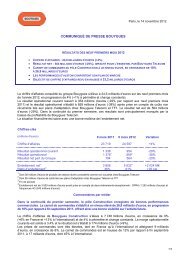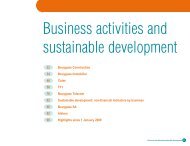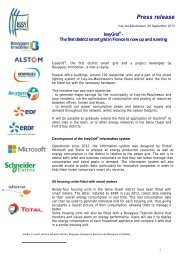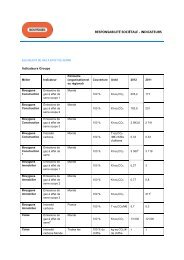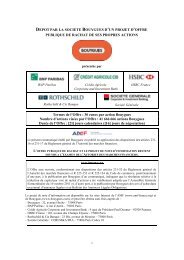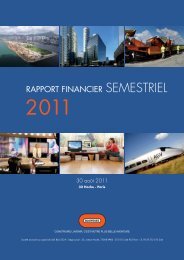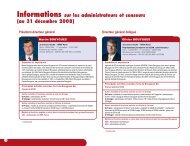Registration Document BOUYGUES
Registration Document BOUYGUES
Registration Document BOUYGUES
You also want an ePaper? Increase the reach of your titles
YUMPU automatically turns print PDFs into web optimized ePapers that Google loves.
3<br />
Risk factors<br />
Business-specific risks<br />
Regulatory risk<br />
CSA broadcasting licence and enforcement<br />
powers<br />
TF1 is an audiovisual communications service that<br />
requires a licence. The company's initial licence to<br />
use frequencies for a period of 10 years from 4 April<br />
1987 (Law of 30 September 1986) expired in 1997.<br />
Based on Decision No. 96-614 of 17 September<br />
1996, the channel received an initial five-year<br />
renewal of this licence effective on 16 April 1997,<br />
with no requirement for a competitive tender.<br />
The TF1 channel's broadcasting licence was<br />
automatically renewed for the period 2002-2007<br />
by decision of the CSA on 20 November 2001.<br />
Under Article 82 of the Law of 30 September<br />
1986, as amended, this licence was automatically<br />
be extended to 2012 in return for simulcasting the<br />
digital terrestrial free-to-air channel. The CSA, in a<br />
decision of 10 June 2003, modified the TF1 licence<br />
and contract terms to build in stipulations about<br />
the transfer of the channel's programming to DTT.<br />
The Future Audiovisual and Television Broadcasting<br />
Modernisation Act of 5 March 2007 introduced two<br />
automatic five-year extensions of TF1's licence.<br />
The first compensated for the early switch-off of<br />
the channel's analogue signal on 30 November<br />
2011 and was subject to TF1 joining the consortium<br />
set up to implement the analogue switch-off. The<br />
second was in return for the channel's commitment<br />
to provide DTT coverage to 95% of the French<br />
population. Accordingly, TF1's licence is now set<br />
to expire in 2022.<br />
The TF1 group is subject to a variety of commitments<br />
covering general obligations to broadcast<br />
and invest in production, either through its schedule<br />
of conditions or as a result of regulations<br />
applicable to its activity. A change to the regulations<br />
could raise the current constraints imposed<br />
on TF1, with a possible negative impact on the<br />
company's profitability.<br />
If TF1 fails to meet its contractual obligations, the<br />
CSA can, after giving formal notice and depending<br />
on the severity of the offence, impose one of<br />
the penalties set forth in Article 42(1) of the Law<br />
of 30 September 1986. These include a fine;<br />
a temporary ban (of no more than one month)<br />
on producing, broadcasting or distributing the<br />
service, or a category of programme, or part of a<br />
programme; reducing the term of the licence to use<br />
frequencies by up to one year. TF1's compliance<br />
with its obligations is strictly monitored. It has a<br />
dedicated Programme Compliance department<br />
to ensure that the channel's programmes comply<br />
fully with regulatory requirements.<br />
Privacy law and defamation<br />
There are no cases pending that present a financial<br />
risk to TF1.<br />
Risk of additional taxes<br />
Article 53 of the Law of 30 September 1986, as<br />
amended by the Finance Act 2011, deferred the<br />
complete end to advertising on France Télévisions<br />
(the public service broadcaster), initially set for<br />
2012, until 1 January 2016. In exchange for the<br />
postponement, the tax paid by the channels to<br />
make up the France Télévisions' deficit has been<br />
lowered to 0.5% of advertising revenues until<br />
1 January 2016.<br />
This example is a good illustration of the risk of new<br />
taxes to which television channels are exposed,<br />
such as the tax on advertising spending.<br />
Operational risk management policy<br />
The TF1 group has put new risk monitoring and<br />
control systems in place across the board for all<br />
of its businesses.<br />
Bouygues Telecom<br />
Infrastructure access<br />
In a sector characterised by cycles of technological<br />
change, one of the major challenges facing<br />
Bouygues Telecom is to access infrastructure on<br />
the best possible cost terms within a timeframe<br />
that enables it to meet consumer needs for new<br />
services on a timely basis.<br />
Bouygues Telecom has embarked on projects<br />
that will make it a key player in the fixed-line veryhigh-speed<br />
broadband market. Since November<br />
2010, Bouygues Telecom has been using the<br />
Numericable network and marketing its Bbox fibre<br />
service, which offers faster speeds than ADSL. An<br />
agreement with SFR to jointly deploy a fibre optic<br />
network with 3 million connections into the home,<br />
signed on 9 December 2010, will make Bouygues<br />
the only Internet service provider simultaneously<br />
offering ADSL, cable and fibre optic services.<br />
In the very-high-speed mobile business, Bouygues<br />
Telecom has acquired a significant number of<br />
2,600 MHz and 800 MHz frequencies enabling it<br />
to provide very high speed services across France<br />
in the coming years.<br />
Competition<br />
The French electronic communications market<br />
is highly competitive. Competition is likely to<br />
become tougher in 2012 with the entry into the<br />
French mobile telephony market of a new operator<br />
which has been awarded the fourth UMTS<br />
licence and allowed to benefit from asymmetric<br />
regulatory measures never before granted to any<br />
other operator.<br />
In this competitive environment, Bouygues Telecom<br />
has embarked on a new direction, launching new<br />
offers:<br />
> it has created B&YOU, a community forumbased<br />
brand at the heart of social networks sold<br />
exclusively online with no minimum commitment<br />
and targeted at the most autonomous members<br />
of the Internet generation able to manage all<br />
contact with their service provider online;<br />
> it has also launched Eden, a tailored range of<br />
offers catering to customer requirements (with or<br />
without a minimum commitment, with or without<br />
a handset and with a new customer loyalty<br />
programme, etc.), in order to supplement and<br />
simplify its services;<br />
> a new premium service that guarantees next day<br />
replacement for handsets that are damaged,<br />
lost, stolen or faulty.<br />
It is also one of the company's core objectives to<br />
improve its position on the internet and fixed phone<br />
market. Bouygues Telecom is already the market<br />
leader in terms of net growth, attracting 433,000<br />
new customers in 2011 and increasing the number<br />
of its fixed-line customers to more than 1.2 million<br />
as at end December 2011.<br />
Adverse regulatory and tax changes<br />
In a strict regulatory and fiscal environment, new<br />
taxes and regulatory restrictions are being applied<br />
to fixed and mobile services at both European and<br />
national level. Because of the potential impact<br />
on company profitability, Bouygues Telecom is<br />
constantly on the lookout for such developments<br />
<strong>BOUYGUES</strong> • 2011 <strong>Registration</strong> <strong>Document</strong> • RISK FACTORS • 145



